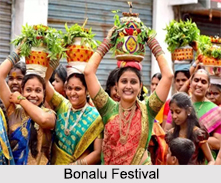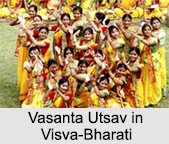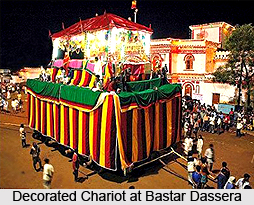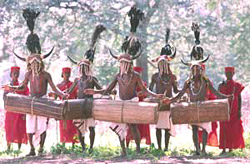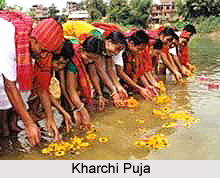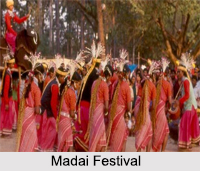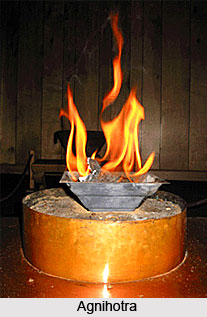 "Agnihotra" is ceremony of mainly Hindu families of India, which is performed for the healing and scientific process of purification of the atmosphere. "Agnihotra" is also performed to get the sacred ash or `vibhuti`. It is done with the agency of cosmic element fire, which creates pure nutritional and medicinal atmosphere and prevents growth of the pathogenic bacteria.
"Agnihotra" is ceremony of mainly Hindu families of India, which is performed for the healing and scientific process of purification of the atmosphere. "Agnihotra" is also performed to get the sacred ash or `vibhuti`. It is done with the agency of cosmic element fire, which creates pure nutritional and medicinal atmosphere and prevents growth of the pathogenic bacteria.
`Agni` or ` fire` is the universal power or energy on an understandable human level. Any human being can relate to `fire` as it is the expression of the Almighty. In the `Agnihotra`, the term `Agni` stands for fire and `Hotra` stands for `healing`. `Agnihotra` is a Vedic Yajna performed generally by the members of orthodox Hindu families. A few group of people still perform the Vedic form of this ritual of `Agnihotra`. The root of "Agnihotra" can be traced back to the Vedas, which is the most ancient science of bio-energy, medicine, agriculture and climate engineering. The `Grihyasutras` has given a simple version of the "Agnihotra" in the post Vedic eras.
All mankind regardless of its race, religion and language can perform `Agnihotra`. It is not restricted to the Hindu families. Anyone who can speak i.e, have the ability of speech is capable of performing `Agnihotra`. It is the first step of salvation and every human being has a birthright to seek it. If any person wants to remain well in all way, his mind has to remain first. The mind and the `prana` (breath) are undividable and "Agnihotra" impacts both mind and breathe. It gives the mind a natural contentment and the ability to react with unconditional love.
The ritual of "Agnihotra" involves other few supplementary events i, e, the worship of the three (or five) sacred fires. Generally, a Brahmin or a priest performs this rite for his self-benefit or for another person (Yajmana). The main part of the "Agnihotra" is the two offerings to the `fire` or `Agni`, which are made exactly at the time of sunset and sunrise.
The modern of "Agnihotra" is very simple and can be performed with `nitya` (daily) `karmas` (duties) for example, Sandhyavandanam and Samidhadanam. In earlier days, the upper class man along with his wife generally performed it. But now, it is open for all the `varnas` and `castes` and both genders can perform it. The main thing is the faith and devotion of the performer.
The materials, which are required for performing "Agnihotra" are-
1. Pyramid: It is a copper pot, which is also known as the `Agnihotra pot` and its shape and make up is very scientific.
2. Rice: Whole grains of rice, which are used for offering.
3. Ghee: It is made from unsalted cow`s butter.
4. Cow dung: Dried chunks of pieces of cow dung
5. Mantras: These are the most important and very powerful voice/thought combination required for the ritual.
6. Copper dish
7. Copper spoon
8. Gugul - Loban, which is required for igniting "Agnihotra" fire.
9. Copper fork and last but not the least
10. Local sunrise.
All these together create a positive energy around the place. And one starts to experience peace and harmony around himself/herself by practicing it.
The procedure of "Agnihotra" needs the following preparations-
• Few cow dung chips are smeared with ghee and kept them in the "Agnihotra pot".
• A teaspoon full of rice is mixed with a little ghee and kept aside.
• Blazing the fire of the "Agnihotra" with the dried cowdung cakes in a small copper pot few minutes before the sunrise/sunset time.
At first, a small piece of the cowdung cake is placed in the copper pot and gugul, camphor or a cotton wick soaked in cow`s ghee is put on it. The fire is put on with a matchstick or in earlier days it used to be done by the churning of a fire stick on a base plate. A hand-held fan is used to fully ablaze the fire. Now, two pinchful of clean and unbroken rice is taken in the left palm or in a small dish. Then the cowdung chips, which are already smeared by the ghee, are divided in two parts.
Now the morning "Agnihotra" ritual will start with the sunrise. As soon as the sun rises, one part of the rice grains are offered to the fire, with the utterance of this mantra, "Sooryaya Swaaha- Sooryaya Idam Na Mama". The oblation is offered when saying `Swaaha`. This mantra means,` this belongs to the Sun, not to me`.
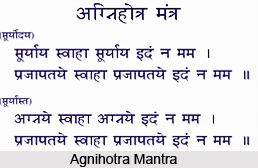 Afterwards, the second line of the mantra is chanted along with second oblation to the fire, i, e, the other part of the rice. The second mantra is, "Prajapataye Swaaha- prajapataye Idam Na Mama". This time also the oblation is offered, when the word `Swaaha` is uttered. The person offering the oblations must concentrate on the fire till the offerings are fully burnt. And thus the morning "Agnihotra" ends here.
Afterwards, the second line of the mantra is chanted along with second oblation to the fire, i, e, the other part of the rice. The second mantra is, "Prajapataye Swaaha- prajapataye Idam Na Mama". This time also the oblation is offered, when the word `Swaaha` is uttered. The person offering the oblations must concentrate on the fire till the offerings are fully burnt. And thus the morning "Agnihotra" ends here.
The evening "Agnihotra" starts exactly at the sunset time but before that the morning "Agnihotra" ash is removed from the pot very carefully and kept in a box aside. Now, the morning process is repeated by preparing a fresh fire from the cowdung chips in the pot. And the two parts of rice offering are also prepared. Exactly when the sun sets, the chanting of "Agnihotra" mantra starts and the first oblation is offered as the term "swaaha` is chanted as done in the morning. The mantra is- "Agnaye Swaaha-agnaye Idam Na Mama", which means `this unto `Agni`, not me.`
In the same way, the second line of the mantra, "Prajapataye Swaaha-Prajapataye Idam Na Mama" is chanted and the second part of the oblation is offered while uttering `Swaaha`. This time also, the `Yajman` should concentrate on the fire till it burns fully. Thus, the evening "Agnihotra" concludes here.
The "Agnihotra" ritual has various good effects. As the "Agnihotra" ritual takes place, the entire universe pulsates with a coordinated rhythm and harmonises the orbits of the moon, planets, earth and sun. The human beings align and realign this rhythm precisely at the sunset/sunrise transition point. The "Agnihotra" ritual harmonises between the mind, body and the universe. There is an intense energy, which emerges from the "Agnihotra" pot. The ritual also neutralises the harmful radiation and pollutants. It renews the brain cells and purifies the whole psychosomatic man in a holistic way. The harmful radioactive radiations are also neutralised in the atmosphere of "Agnihotra". It has a nourishing effect on the nature and the nervous system. It is said that the plants grow in extraordinary way with flower and fruits when they are around the "Agnihotra" atmosphere.
The copper of the pot acts as the generator to produce negative ions, when the cowdung burns in the pyramid shaped copper pot. These negative ions have a harmonising effect both in the environment and in the human being, which acts as disinfector and decreased the disease causing bacteria. The cowdung chips, which are used in the "Agnihotra", have penicillin like substance. The initial organic materials are released into the environment during the burning of the materials but some parts are also left in the remaining ash. The ghee burned in the "Agnihotra" also has detoxification properties. The nutrients for plants are released in during the combustion process. They develop cylindrical veins with an above average diameter. Thus water and nutrients can reach more easily to all the parts of the plant and they grow rapidly. The smoke of the "Agnihotra" also serves as catalyst for the production of chlorophyll in plants. The fruits and vegetables grown during that time have better taste, colour and size. The rice also releases many etheral oils during the process. The mantras chanted during "Agnihotra" changes the structure of the atoms also because it creates such vibrations in resonance with the biorhythm. The physical health of human being is also influenced by it as the purification process through `Homa` intensifies the life energy (prana). The regular performance of "Agnihotra" decreases the anger and greed in a person. Even the vigorous mood changes are reduced and the person becomes calmer. Nothing is destroyed in "Agnihotra, it only gets transformed." The fine changes in the molecular structure can be seen by Kilian photography. The `Homa` benefits the whole ecosystem of the earth.
